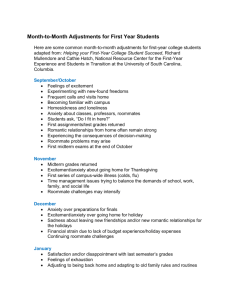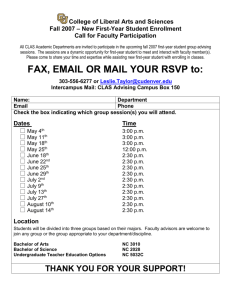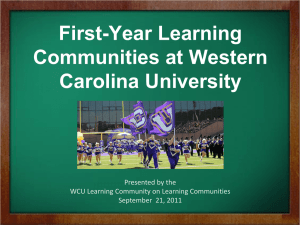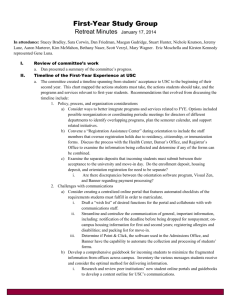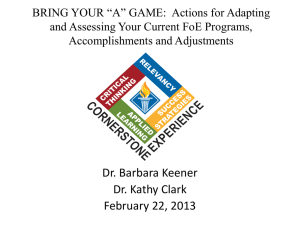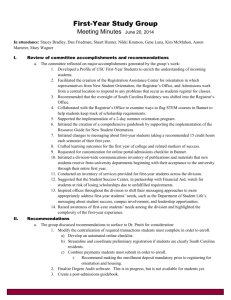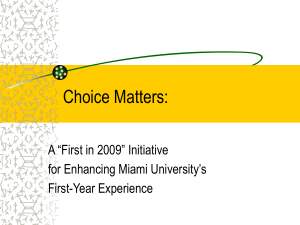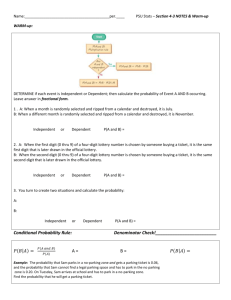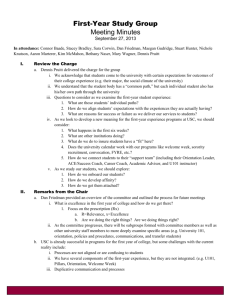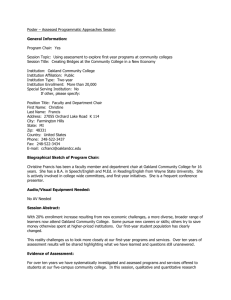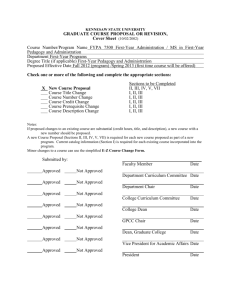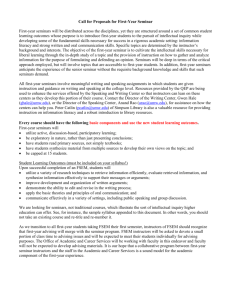section 4
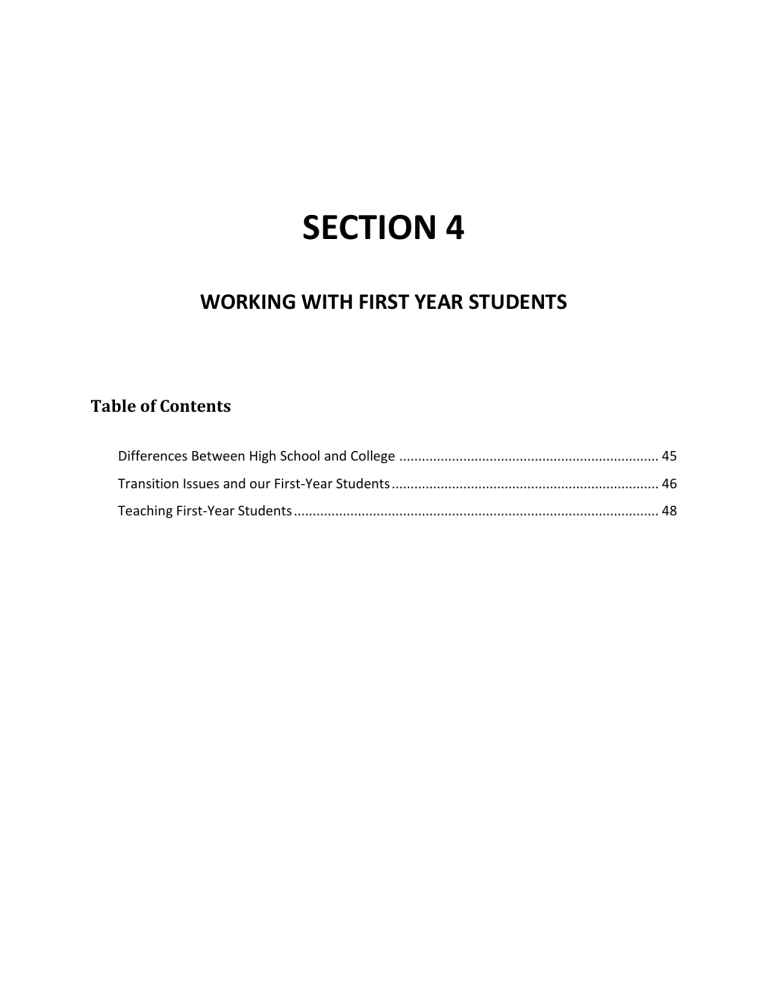
SECTION 4
WORKING WITH FIRST YEAR STUDENTS
Table of Contents
Differences Between High School and College ..................................................................... 45
Transition Issues and our First-Year Students ....................................................................... 46
Teaching First-Year Students ................................................................................................. 48
DIFFERENCES BETWEEN HIGH SCHOOL AND COLLEGE
It’s important to remember that many, if not all, of the students in your UI100 class will be traditionally-aged college students. They will have graduated high school in May and are starting college with us in August. Many of them have no idea how to operate in a college classroom and we can assist them by remembering a few of the differences they may struggle with as a new student.
High School
Teacher/Student Contact – Contact closer and more frequent (5 days a week)
Competition/Grades – Academic competition is not as strong; good grades can often be obtained with minimum effort.
Status – Students establish a personal status in academic and social activities based on family and community factors.
Counseling/Dependence – Students can rely on parents, teachers, and counselors to help make decisions and give advice. Students must abide by parents’ boundaries and restrictions.
Motivation – Students get stimulation to achieve or participate from parents, teachers, and counselors.
Freedom – Students’ freedom is limited. Parents will often help students out of a crisis should one arise.
Distractions – There are distractions from school, but these are partially controlled by school and home.
Value Judgments – Students often make value judgments based on parental values; thus, many of their value judgments are made for them.
College
Teacher/Student Contact – Faculty are available during office hours (only a few hours a week) and by appointment to address students’ concerns.
Competition/Grades – Academic competition is much stronger; minimum effort may produce poor grades.
Status – Students can build their status as they wish; high school status can be repeated or changed.
Counseling/Dependence – Students rely on themselves; they see the results of making their own decisions. It is their responsibility to seek advice as needed. Students set their own restrictions.
Motivation – Students apply their own motivation to their work and activities as they wish.
Freedom – Students have much more freedom.
Students must accept responsibility for their own actions.
Distractions – The opportunity for more distractions exists. Time management to students will become more important.
Value Judgments – Students have the opportunity to see the world through their own eyes and develop their own opinions and values.
ADAPTED FROM UNIVERSITY OF SOUTH CAROLINA’S FACULTY RESOURCE MANUAL
Mullendore, R.H., & Hatch, C. (2000). Helping your first-year college student succeed: A guide for parents.
Columbia, SC: University of South Carolina, National Resource Center for The First-Year Experience and Students in
Transition. All rights reserved.
TRANSITION ISSUES AND OUR FIRST-YEAR STUDENTS
Certain times during the academic year tend to be universally challenging to students. Those who understand the ups and downs of the first college year are better able to help students negotiate the challenges of transitioning to college. Below are some typical adjustment/transition issues that our students face throughout their first year.
August/September o Excitement o Testing new-found freedom o Frequent calls and visits home o Homesickness and loneliness o Anxiety about roommates, professors, classes o First exams
October o Roommate problems begin to arise o Students begin to question: “Do I fit in here?” o First test grades returned o Midterm exams o Love relationships from home remain strong, or fall apart (this is usually the time high school sweet hearts break up) o Consequences of decision-making are experienced
November o Midterm grades returned o Roommate challenges become more clear o Many exams and papers due before Thanksgiving o Excitement and/or anxiety regarding going home for Thanksgiving o First series of campus-wide illness (cold, flu, strep, etc.)
December o Anxiety over preparing for finals o Excitement and/or anxiety regarding going home for the holidays o Sadness about leaving new friendships and/or love relationships
January o “Fresh Start” mentality sets in with new term o Satisfaction and/or disappointment with fall term grades o Homesickness o Loneliness for love relationship back home o Relief being away from home and back at school
February o Feelings of claustrophobia and depression set in with winter o Potential increase in alcohol and other substance abuse o Challenges with love relationship back home o Valentine’s Day brings out loneliness and isolation
March o Anxiety regarding finding roommate(s) for next year o Excitement and/or disappointment regarding Spring Break plans o Midterm exam stress o Concern over summer employment o Concern over winter weight gain
April o Excitement with arrival of spring o Concern over declaring major o End of semester pressure
May o Final exam anxiety o Apprehension about returning home for summer o Sadness over leaving new friendships and/or love relationships at school o Realization of how college influences life decisions
In addition to these more predictable stressors, students may experience the following concerns throughout the academic year: o Missing family birthday and holiday celebrations o Missing participation in family traditions o Some involvement with family is maintained, but students expect their desire for complete freedom to be respected.
ADAPTED FROM UNIVERSITY OF SOUTH CAROLINA’S FACULTY RESOURCE MANUAL
Mullendore, R.H., & Hatch, C. (2000). Helping your first-year college student succeed: A guide for parents.
Columbia, SC: University of South Carolina, National Resource Center for The First-Year Experience and
Students in Transition. All rights reserved.
TEACHING FIRST-YEAR STUDENTS
Provide Feedback, Early & Often – First-year students making the transition from excelling in high school to meeting expectations in a college class can benefit from feedback, early and often in the semester. A student who must wait several weeks for the first test to get a sense of how she’s doing in the course might have trouble catching up to her peers.
Minimize Memorization – Setting instructional goals that can be met by memorization reinforces students’ naïve beliefs about learning. While some memorization is necessary in many courses, success in a course shouldn’t be possible solely through memory work.
Clarify Expectations for Learning – Since students have naïve ideas about knowledge and learning, instructors should clarify their expectations for student learning and performance.
Help students understand what is expected of them via description, examples, and feedback on student work.
Clarify Strategies for Learning – Not only do first-year students not understand what is expected of them, even when they are clear on those expectations, they don’t know how to go about meeting those expectations. Help students understand and practice approaches to learning in and out of the classroom—listening for key ideas in a lecture, learning from a discussion, reading for comprehension, preparing for exams—that will help them make the transition to the kinds of thinking expected of them as college students.
Teach to a Variety of Learning Styles – We often teach as we were taught, but we were rather exceptional compared to our student peers—we went on to graduate school in our chosen disciplines. Be sensitive to the variety of ways that students excel at learning and include a variety of types of learning experiences in your courses to reach the broadest group of students as you can.
Have Students Write Letters to Their Successors – Ask students to write a letter to next year’s students focusing on advice for succeeding in your course. These letters help your current students reflect on and cement what they’ve learned, they help you learn about your students’ experiences in your course, and they help next year’s students adapt more quickly to the rigors of college studies.
TAKEN AND ADAPTED FROM VANDERBILT UNIVERSITY’S CENTER FOR TEACHING: http://cft.vanderbilt.edu/teaching-guides/interactions/firstyears/
